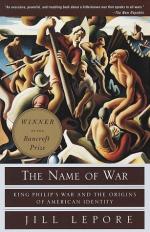
|
| Name: _________________________ | Period: ___________________ |
This test consists of 5 multiple choice questions, 5 short answer questions, and 10 short essay questions.
Multiple Choice Questions
1. The colonists lost about how many men in the Great Swamp Fight?
(a) 70.
(b) 59.
(c) 67.
(d) 25.
2. Sassamon was a Christian minister in what Indian praying town?
(a) Wampapaquan.
(b) Quebec.
(c) Namasket.
(d) Nahauton.
3. When did Hugo Grotius die?
(a) 1677.
(b) 1672.
(c) 1645.
(d) 1642.
4. Who is thought to have mentored John Sassamon?
(a) Increase Mather.
(b) John Eliot.
(c) John Alderman.
(d) James Williams.
5. Who served as governor of Plymouth Colony from 1673 to 1680?
(a) Josiah Winslow.
(b) William Hubbard.
(c) Richard Callicot.
(d) John Alderman.
Short Answer Questions
1. The first English settlers arrived in what year, when Sassamon's parents may have welcomed them?
2. Who is credited with the founding of Medfield, Massachusetts?
3. William Hubbard graduated Harvard in what year?
4. According to the author, the English were particularly brutal when they attacked the Narragansetts' Great Swamp on what date?
5. When was the book A Relation of the Troubles which Have Hapned in New-England by Reason of the Indians There from the Year 1614 to the Year 1675 published?
Short Essay Questions
1. How is the early life of John Sassamon described in Part One, Language, Chapter 1, Beware of Any Linguist?
2. How does the author describe the Puritans' impression of America and Native Americans upon arriving in Part Two, War, Chapter 3, Habitations of Cruelty?
3. What was problematic for the Puritans in their plight to maintain a civil identity, as discussed in the Prologue?
4. How was John Sassamon involved in King Philip's War, as discussed in Part One, Language, Chapter 1, Beware of Any Linguist?
5. What motivations and ethics are described of the Indian tribes for the war in Chapter 4, Where is Your O God?
6. How is Natural Law and Just War theory described in Chapter 4, Where is Your O God?
7. What did the colonists believe of the Indian powwaws? How did this shape their view of the war, as discussed in Chapter 4, Where is Your O God?
8. How does the author describe the English identity of the colonists in 1676 in the Prologue of The Name of War: King Philip's War and the Origins of American Identity?
9. How did Nathaniel Saltonstall describe the war in relation to the body, as discussed in Part Two, War, Chapter 3, Habitations of Cruelty?
10. How does the author describe the portrayal of Native Americans among the colonists in Part Two, War, Chapter 3, Habitations of Cruelty?
|
This section contains 898 words (approx. 3 pages at 300 words per page) |

|




